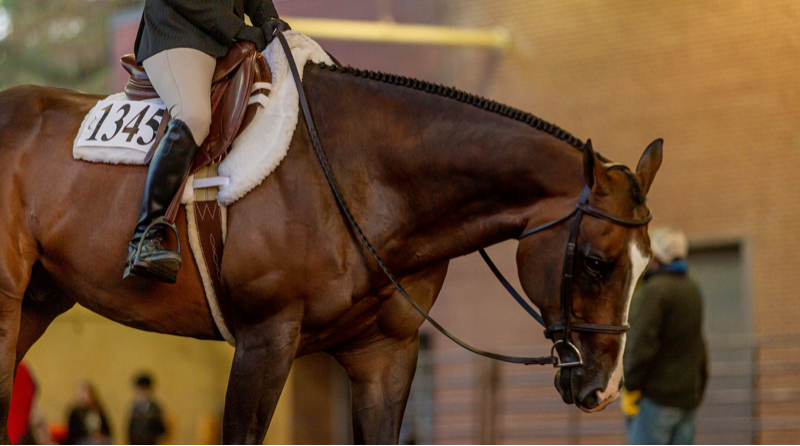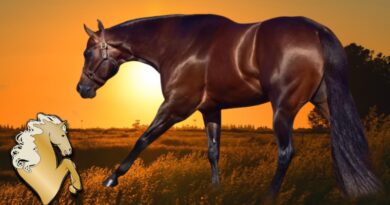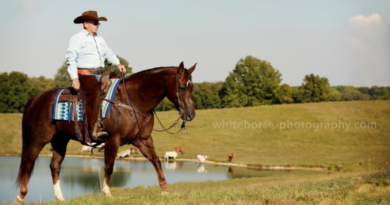HUS First Impressions
You only get one chance to make a first impression in hunter under saddle class.
AQHA Professional Horsewoman Casi Vician of Mentor, Ohio, points out that a horse’s movement and turnout are complemented by attire, and a carefully planned presentation can leave a lasting impression with the judges.
“AQHA judges ae well-educated on our breed standard for each class,” she says.
Hunter under saddle is a preliminary class for English riding disciplines. Judges emphasize smooth gaits, a free-flowing stride and willingness to perform. Horses, not the riders, are judged on the flat at a walk, trot and canter.
During the class, exhibitors are expected to show in two directions, but it’s the first few strides through the in-gate that can have the biggest impact on a judge’s scorecard, she says.
“Class entrance and how your horse should appear for that trot-in is especially important in hunter under saddle classes,” she says.
Judges are looking for a horse that has a happy, willing expression. The horse’s ears should be forward or relaxed. Casi compares this look to that of a dressage horse with a closed, quiet mouth and even a little foam or saliva to show the horse is working well on the bit.
The ideal hunter under saddle horse has its nose positioned at or in front of the vertical line, and its poll should be even with its withers.
Watching the Movement
First impressions are important, but the rest of the class has weight also. A horse that looks like it is enjoying its job will catch the judges’ attention at the in-gate, but what happens in the arena is what holds the judges’ attention.
Once all the riders are through the in-gate, the judges are watching for movement at the walk, trot and canter. The walk should be a true, ground-covering four-beat gait, with the hind foot tracking up to the footprint the forefoot left, Casi says.
“All horses being shown at the walk in an AQHA class should be moving freely forward, ready to be set loose on the hunt across country, thus the concept of a hunter under saddle,” she says.
To achieve this ground-covering pace, the horse should be on the bit, and the rider should have contact with the horse’s mouth, removing any slack in the reins. However, tugging or pulling on the horse’s mouth is unacceptable.
When the judges call for the trot, Casi watches for a trot that has “hang time.” The entire shoulder should be reaching forward and engaged in every step. The momentum of the trot should come from a strong hind end rather than from the front end or elbow. Even at this quicker gait, the horse is expected to maintain a comfortable expression and be looking through the bridle to the path ahead of it.
Casi likes to show hunter under saddle horses off the rail a bit, where they are easily maneuvered and the rider can effortlessly look ahead and guide a horse through the class traffic.
The canter can make or break a ride, she says.
When asked to step into the canter, horses that drive from a strong hind end stand out in a crowded pen.
The inside shoulder should still be reaching, and the toe should be pointing. It’s especially important at this gait that the rider avoid interfering with the horse’s head and neck and instead maintain light contact. The horse’s shoulder should reach forward with every stride while the poll remains even with the withers and the nose is at or in front of the vertical.
“A mistake I see far too often in the hunter under saddle classes is a horse’s nose being pulled to the outside of the pen,” she says. “The horse’s nose should be slightly inward, not outward at the canter.”
After showing at all three gaits in both directions, the final requirement, the backup, can carry as much weight as the forward-moving gaits. The back should be straight and easy, but never rushed or fast like a reining maneuver.
Be careful when you pull backward. Exaggerated hand movements encourage a gaping at the mouth, which deducts points.
“When a HUS horse is asked to back up, the rider should back the horse with leg cues and minimal rein pulling and the backward momentum should stop when the leg pressure is released, not the hands,” she says.
The emphasis in the class is on the horse and its movement. A rider with good equitation will create a polished picture. However, since the class is judged on the horse, riders with less-than-perfect equitation can succeed in hunter under saddle if their horses have free flowing, correct movement, she says.
A Polished Presentation
The horse’s turnout will not determine the overall standings, but a thorough grooming helps exhibitors stand out from the crowd, especially in big classes with seasoned riders.
Casi likes the complete package, almost as if a horse were being prepared for a halter class, including hoof black and tails. Ears should be clipped, faces should be oiled, and the mane should be braided on the horse’s right side in neat hunter-style braids with yarn or string matching the color of the mane.
Regardless of discipline, a cleanly clipped bridle path is a must, and it shouldn’t be clipped more then 2 or 3 inches back on the mane, she says.





